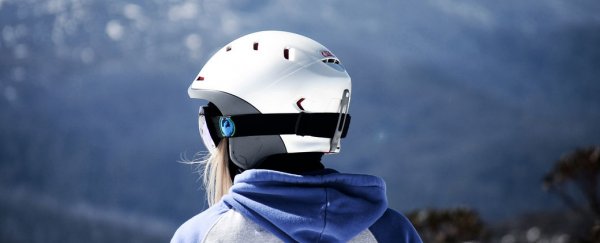The ski fields are a fun place to test your limits, racing down snow-covered hills at high speeds and hitting the occasional jump (sometimes by accident).
If you've ever tried to document your downhill adventures, however, you're likely familiar with the frosty finger that can come from handling cameras and smartphones without gloves. You've probably experienced how difficult it can be to communicate with friends, particularly if you get split up on the mountain.
To solve some of these problems, a trio of graduates from UNSW in Australia - including a former student from UNSW Engineering - have developed an innovative ski helmet that does a lot more than protect its user against head injuries.
According to the developers, the Alpine Helmet is kitted-out with a full HD camera for filming your epic skills (and epic crashes). It also has GPS and stereo speakers (because, let's face it, you're practically naked on the ski hill unless you're bumping some obnoxious tunes), plus a noise-cancelling microphone to communicate with friends via Wi-Fi and Bluetooth, with the touch-sensitive volume controls located on the exterior flap covering the ear.
In addition, the helmet has impact sensors, fog lights, a microcomputer that can keep track of falls, and an emergency beacon - just in case you thought all the other gadgets were somehow detracting from the top priority of keeping you safe.
"The head is where everything happens and a helmet is a great platform to fit all these electronics to provide extra information such as your speed or where your friends are," lead developer and founder of Forcite Helmet Systems, Alfred Boyadgis, said in a UNSW press statement.
"The way that helmets are designed at the moment is quite archaic," Boyadgis told The Sydney Morning Herald back in 2013, after the newspaper profiled a robo-cop-inspired motorcyclke helmet he developed for police officers. "There's no direct electronics in there and, if you think about it, everyone has a smartphone, and all the luxuries of smart technology aren't with riders. They're still using strap-on GPSs and they have no ability to communicate with each other in a safe manner with something that's integrated."
 The award-winning Forcite motorcycle helmet developed by UNSW graduate Alfred Boyadgis (Credit: Forcite)
The award-winning Forcite motorcycle helmet developed by UNSW graduate Alfred Boyadgis (Credit: Forcite)
The latest helmet has been designed with the help of his two business partners: industrial designer Julian Chow and UNSW Engineering graduate George Constantinos. The trio were supported by the University's commercialisation company en route to developing their company, and were also granted some seed money from the New South Wales state government.
Boyadgis says their latest design needed to incorporate new technology affordably, without compromising safety standards.
"A helmet is meant to protect you, it's meant to be replaced, and that's something we had to factor into the design," Boyadgis says. "The top shell, the phone, the speakers, the camera, the computer, the battery – are all elements that you can pull apart, and put back together again for a reasonably affordable price."
"We have had more than 2500 registers of interest in the Alpine Helmet and we're currently looking for further investment opportunities," says Boyadgis.
The Forcite team hopes to have the Alpine Helmet available this year, and is exploring opportunities to create more protective headwear for use on motorcycles and bikes, and for the emergency services and mining sectors.
Find out more about the game-changing research being done at UNSW Engineering.
Sources: UNSW Engineering, The Sydney Morning Herald
